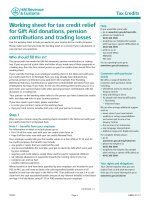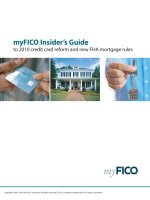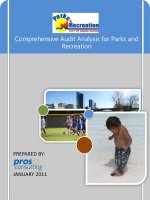HUD 4155.1, Mortgage Credit Analysis for Mortgage Insurance potx
Bạn đang xem bản rút gọn của tài liệu. Xem và tải ngay bản đầy đủ của tài liệu tại đây (1.53 MB, 413 trang )
HUD 4155.1 Table of Contents
i
HUD 4155.1, Mortgage Credit Analysis for Mortgage
Insurance
Chapter 1. Underwriting Overview
Section A. General Information on the Underwriting Process
Overview 1-A-1
1. General Information on Underwriting and Credit Policy 1-A-2
2. Maximum Loan Limits, Mortgage Amounts and Mortgage Terms 1-A-3
3. Policies on Interest Rates and Related Fees 1-A-9
4. General Information on Mortgage Credit Analysis 1-A-11
5. Borrower Approval or Rejection 1-A-13
Section B. Documentation Requirements
Overview 1-B-1
1. General Documentation Standards 1-B-2
2. Required Documents for Mortgage Credit Analysis 1-B-9
3. Mortgage Loan Application Document Processing 1-B-20
Section C. Credit Reporting Requirements
Overview 1-C-1
1. Confidential Nature of Credit Information 1-C-2
2. General Information on Traditional and Non-Traditional Credit Reports 1-C-3
3. Three Repository Merged Credit Report (TRMCR) 1-C-6
4. Residential Mortgage Credit Report (RMCR) 1-C-8
5. Non-Traditional Credit Report (NTMCR) Requirements 1-C-9
Chapter 2. Maximum Mortgage Amounts/Cash Investment Requirements on Purchase
Transactions
Section A. Calculating Maximum Mortgage Amounts on Purchase Transactions
Overview 2-A-1
1. Maximum Mortgage Amounts on Purchases 2-A-2
2. Calculating Maximum Mortgage Amounts on Purchases 2-A-4
3. Interested Third Party Contributions 2-A-6
4. Inducements to Purchase 2-A-8
5. Additions to the Mortgage Amount for Repair and Improvement 2-A-11
Continued on Next Page
Table of Contents HUD 4155.1
ii
HUD 4155.1, Mortgage Credit Analysis for Mortgage
Insurance,
Continued
Section B. Transactions Affecting Maximum Mortgage Calculations
Overview 2-B-1
1. General Information on Transactions Affecting Maximum Mortgage
Calculations 2-B-2
2. Identity of Interest Transactions 2-B-3
3. Non-Occupying Borrowers 2-B-6
4. Transactions Involving Three and Four Unit Properties 2-B-8
5. Loan Transactions for Building on Own Land 2-B-10
6. Loan Transactions for Paying Off Land Contracts 2-B-12
7. Transactions Involving Properties For Proposed Construction, Under Construction
or Existing Construction Less Than One Year Old 2-B-14
8. Manufactured Home Construction-Permanent Loans 2-B-16
Chapter 3. Maximum Mortgage Amounts on Refinance Transactions
Section A. Refinance Transaction Overview
Overview 3-A-1
1. General Information on Refinance Transactions 3-A-2
Section B. Maximum Mortgage Amounts on No Cash Out/Cash Out Refinance
Transactions
Overview 3-B-1
1. No Cash Out Refinance Transactions With an Appraisal 3-B-2
2. Cash Out Refinance Transactions 3-B-8
Section C. Maximum Mortgage Amounts on Streamline Refinances
Overview 3-C-1
1. General Information on Streamline Refinances 3-C-2
2. Streamline Refinances Without an Appraisal 3-C-3
3. Streamline Refinances With an Appraisal (No Credit Qualifying) 3-C-7
Chapter 4. Borrower Eligibility and Credit Analysis
Section A. Borrower Eligibility Requirements
Overview 4-A-1
1. Borrower, Coborrower, and Cosigner Eligibility Requirements 4-A-2
2. Eligibility for FHA-Insured Financing 4-A-6
3. Citizenship and Immigration Status 4-A-13
4. Living Trusts 4-A-15
5. Non-Purchasing Spouses 4-A-16
Continued on Next Page
HUD 4155.1 Table of Contents
iii
HUD 4155.1, Mortgage Credit Analysis for Mortgage
Insurance,
Continued
6. Eligibility Requirements for Nonprofit Organizations and State and
Local Government Agencies 4-A-18
7. Using CAIVRS to Determine Eligibility for FHA Insured Mortgage Transactions 4-A-21
Section B. Property Ownership Requirements and Restrictions
Overview 4-B-1
1. General Information on Property Requirements and Restrictions 4-B-2
2. Eligibility Requirements for Principal Residences 4-B-5
3. Eligibility Requirements for Secondary Residences 4-B-9
4. Investment Property Eligibility and Underwriting Requirements 4-B-11
Section C. Borrower Credit Analysis
Overview 4-C-1
1. General Guidelines for Analyzing Borrower Credit 4-C-2
2. Guidelines for Credit Report Review 4-C-7
3. Evaluating Non-Traditional Credit and Insufficient Credit 4-C-16
4. Borrower Liabilities: Recurring Obligations 4-C-18
5. Borrower Liabilities: Contingent Liability 4-C-21
6. Borrower Liabilities: Projected Obligations and Obligations Not Considered
Debt 4-C-23
Section D. Borrower Employment and Employment-Related Income
Overview 4-D-1
1. Stability of Income 4-D-2
2. Salary, Wage and Other Employment Related Income 4-D-5
3. Borrowers Employed by a Family Owned Business 4-D-11
4. General Information on Self-Employed Borrowers and Income Analysis 4-D-12
5. Income Analysis: Individual Tax Returns (IRS Form 1040) 4-D-17
6. Income Analysis: Corporate Tax Returns (IRS Form 1120) 4-D-20
7. Income Analysis: “S” Corporation Tax Returns (IRS Form 1120S) 4-D-22
8. Income Analysis: Partnership Tax Returns (IRS Form 1065) 4-D-23
Section E. Non-Employment Related Borrower Income
Overview 4-E-1
1. Alimony, Child Support and Maintenance Income 4-E-2
2. Investment and Trust Income 4-E-4
3. Military, Government Agency, and Assistance Program Income 4-E-7
4. Rental Income 4-E-10
5. Non Taxable and Projected Income 4-E-15
Table of Contents HUD 4155.1
iv
HUD 4155.1, Mortgage Credit Analysis for Mortgage
Insurance,
Continued
Section F. Borrower Qualifying Ratios
Overview 4-F-1
1. General Information on Borrower Qualifying 4-F-2
2. Qualifying Ratios 4-F-3
3. Compensating Factors 4-F-6
Chapter 5. Borrower Funds to Close
Section A. Settlement Requirements
Overview 5-A-1
1. General Information on Settlement Requirements 5-A-2
2. Settlement Requirements Needed to Close 5-A-3
Section B. Acceptable Sources of Borrower Funds
Overview 5-B-1
1. General Information on Acceptable Sources of Borrower Funds 5-B-2
2. Cash and Savings/Checking Accounts as Acceptable Sources of Funds 5-B-4
3. Investments as an Acceptable Source of Funds 5-B-8
4. Gifts as an Acceptable Source of Funds 5-B-10
5. Gift Fund Required Documentation 5-B-15
6. Property-Related Acceptable Sources of Funds 5-B-18
7. Loans and Grants as Acceptable Sources of Funds 5-B-24
8. Employer Programs as Acceptable Sources of Funds 5-B-26
Section C. Borrower Secondary Financing
Overview 5-C-1
1. General Information on Secondary Financing 5-C-2
2. Government Agency Secondary Financing 5-C-4
3. Nonprofit Agency Secondary Financing 5-C-7
4. Organizations and Private Individuals Providing Secondary Financing 5-C-10
5. Family Member Secondary Financing 5-C-12
6. Secondary Financing for Borrowers 60 Years of Age or Older 5-C-16
Continued on next page
HUD 4155.1 Table of Contents
v
HUD 4155.1, Mortgage Credit Analysis for Mortgage
Insurance,
Continued
Chapter 6. Special Underwriting
Section A. Special Underwriting Instructions
Overview 6-A-1
1. FHA’s TOTAL Mortgage Scorecard 6-A-2
2. Temporary Interest Rate Buydowns 6-A-7
3. Construction Permanent Mortgage Program Eligibility Criteria 6-A-10
4. Construction Permanent Mortgage Program Requirements 6-A-13
5. Construction Permanent Mortgage Documentation Requirements for
Closing and Endorsement 6-A-16
6. Mortgage Insurance for Disaster Victims 6-A-17
7. Energy Efficient Homes 6-A-25
8. Restriction on Advanced Mortgage Payments 6-A-28
9. Condominium Units Utility Expenses 6-A-29
10. HUD Real Estate Owned (REO) Acquisitions 6-A-30
Section B. ARMs
Overview 6-B-1
1. Terms and Definitions 6-B-2
2. General Information on ARMs 6-B-3
3. ARM Underwriting Requirements 6-B-5
4. Interest Rate Index 6-B-9
5. Calculating Interest Rate Adjustments 6-B-13
6. Computing Monthly Installment Payments 6-B-18
7. Annual Adjustment Notice Requirement 6-B-20
8. Failure to Provide a Timely/Accurate Annual Adjustment Notice 6-B-23
9. ARM Assumptions and Transfers of Servicing 6-B-25
10. Tracking ARMs 6-B-27
Section C. Streamline Refinances
Overview 6-C-1
1. General Information on Streamline Refinances 6-C-2
2. Credit Qualifying Streamline Refinances 6-C-6
3. Streamline Refinance Borrower and Property Related Requirements 6-C-8
4. Types of Permissible Streamline Refinances 6-C-11
5. Establishing Net Tangible Benefit of Streamline Refinance 6-C-16
Continued on next page
Table of Contents HUD 4155.1
vi
HUD 4155.1, Mortgage Credit Analysis for Mortgage
Insurance,
Continued
Section D. Energy Efficient Mortgage Program
Overview 6-D-1
1. General Information on the EEM Program 6-D-2
2. Basic EEM Program Requirements and Criteria 6-D-6
3. Home Energy Rating System (HERS) Report Requirements 6-D-12
4. Processing and Underwriting Requirements 6-D-15
Section E. HOPE for Homeowners (H4H) Program
Overview 6-E-1
1. General Information on the HOPE for Homeowners (H4H) Program 6-E-2
Section F. Refinance of Borrowers in Negative Equity Positions Program
Overview 6-F-1
1. General Information on the Refinance of Borrowers in Negative Equity
Positions Program 6-F-2
Chapter 7. Assumptions
1. General Information on Assumptions 7-1
2. Creditworthiness Review for Assumptions 7-5
3. LTV Reduction Requirements for Assumptions 7-8
Chapter 8. [TBD]
Chapter 9. Glossary
1. Glossary of Handbook Terms 9-1
2. Acronyms 9-10
HUD 4155.1 Chapter 1, Section A
1-A-1
Section A. General Information on the Underwriting Process
Overview
Contents
This section contains the topics listed in the table below.
Topic
Topic Name
See Page
1
General Information on Underwriting and
Credit Policy
1-A-2
2
Maximum Loan Limits, Mortgage Amounts
and Mortgage Terms
1-A-4
3
Policies on Interest Rates and Related Fees
1-4-9
4
General Information on Mortgage Credit
Analysis
1-4-11
5
Borrower Approval or Rejection
1-A-13
Chapter 1, Section A HUD 4155.1
1-A-2
1. General Information on Underwriting and Credit Policy
Introduction
This topic contains general information on underwriting and credit policy,
including
• purpose of underwriting
• four C’s of credit, and
•
the general credit policy.
Change Date
October 18, 2010
4155.1 1.A.1.a
Purpose of
Underwriting
The purpose of underwriting is to
• determine a borrower’s ability and willingness to repay a mortgage debt to
limit the probability of default and collection actions, and
• examine the property offered as security to determine if it is sufficient
collateral.
4155.1 1.A.1.b
Four C’s of
Credit
The underwriter evaluates the four C’s of credit to determine a borrower’s
creditworthiness.
The four C’s of credit consist of a borrower’s
• credit history
• capacity to repay
• cash assets available to close the mortgage, and
•
collateral.
Continued on next page
HUD 4155.1 Chapter 1, Section A
1-A-3
1. General Information on Underwriting and Credit Policy,
Continued
4155.1 1.A.1.c
General Credit
Policy
FHA’s general credit policy requirements for underwriting a mortgage
involve
• considering the type of income the borrower needs in order to qualify
• analyzing the borrower’s liabilities to determine creditworthiness, and
•
reviewing ratios, including debt-to-income, and compensating factors.
Chapter 1, Section A HUD 4155.1
1-A-4
2. Maximum Loan Limits, Mortgage Amounts and Mortgage
Terms
Introduction
This topic contains information on maximum loan limits, mortgage amounts
and mortgage terms, including
• the National Housing Act provisions on loan limits
• basic nationwide loan limits
• loan limits for high cost areas
• appeals for higher loan limits
• maximum loan-to-value (LTV) ratios, and
•
maximum mortgage terms.
Change Date
October 18, 2010
Continued on next page
HUD 4155.1 Chapter 1, Section A
1-A-5
2. Maximum Loan Limits, Mortgage Amounts and Mortgage
Terms,
Continued
4155.1 1.A.2.a
National
Housing Act
Provisions on
Loan Limits
The statutory provisions of the National Housing Act establish the maximum
loan limits and mortgage amounts for all FHA mortgage insurance programs.
Maximum loan limits vary depending upon the
• specific program under which a loan is insured
• number of dwelling units in the property (one to four units), and
• geographic location of the property.
Under most programs, the maximum insurable mortgage is the lesser of
• the statutory loan limit for the area, or
• a percentage of the lesser of the
− appraised value, or
− sales price.
References: For more information on calculating maximum mortgage
amounts and maximum loan-to-value (LTV) ratios, see
• HUD 4155.1 2.A
•
HUD 4155.1 3.B, and
•
HUD 4155.1 3.C.
Continued on next page
Chapter 1, Section A HUD 4155.1
1-A-6
2. Maximum Loan Limits, Mortgage Amounts and Mortgage
Terms,
Continued
4155.1 1.A.2.b
Basic
Nationwide
Loan Limits
FHA’s single family mortgage limits are set by county and are tied to
increases in the loan limits established by the Federal Home Loan Mortgage
Corporation (Freddie Mac) in accordance with Section 203(b)(2)(A) of the
National Housing Act, as amended by 12 U.S.C.17091.
Under Section 203(b), the nationwide basic mortgage limits (the floor) may
not
• exceed 150 percent of the Freddie Mac national loan limit, or
• be less than 65 percent of the dollar amount limitation of Freddie Mac.
References: For more information on
• the specific loan limits for each county in the United States, Guam, and the
Virgin Islands, see HUD’s website at www.hud.gov, and
• calculating maximum mortgage amounts and maximum LTV ratios, see
− HUD 4155.1 2.A
− HUD 4155.1 3.B, and
−
HUD 4155.1 3.C.
4155.1 1.A.2.c
Loan Limits for
High Cost
Areas
Section 203(b)(2)(A) of the National Housing Act states that mortgage limits
in high cost areas (the ceiling) may increase to 150 percent of the dollar
amount limitation as described under Section 305(a)(2) of Freddie Mac for a
residence of applicable size.
In these high cost areas, the loan limit is equal to the lesser of
• 115 percent of the area median house price, or
• the statutory ceiling for the high cost areas.
Section 214 of the
NHA provides that mortgage limits for Alaska, Hawaii,
Guam, and the Virgin Islands may be adjusted up to 150 percent of the new
FHA ceilings.
Continued on next page
HUD 4155.1 Chapter 1, Section A
1-A-7
2. Maximum Loan Limits, Mortgage Amounts and Mortgage
Terms,
Continued
4155.1 1.A.2.d
Appeals for
Higher Loan
Limits
Anyone may appeal for a higher loan limit for a
• county within a Metropolitan Statistical Area (MSA) or
• non-metro county not part of an MSA.
It should be noted, however, that legislation enacted in 1998 provided that the
county with the highest median house price in an MSA determines the
mortgage limits of all counties within that MSA. For this reason, any request
for an increase must be accompanied by sufficient housing sales price data to
justify higher limits. The sales price data submitted to support an increase
must be a listing of all one-family properties sold in the area for a period of
time that will vary depending on the volume of sales.
Contact the local Homeownership Center (HOC) for additional information
on appeals of FHA mortgage limits. FHA will not consider an appeal for an
area smaller than a county.
4155.1 1.A.2.e
Maximum LTV
Ratios
A mortgage that is to be insured by FHA cannot exceed a certain percentage
of property value. The maximum LTV ratios vary depending upon the
• type of borrower
• type of transaction (purchase or refinance), and
• stage of construction.
References: For more information on
• maximum LTV ratios for purchase transactions, see HUD 4155.1 2.A
• transactions that affect maximum mortgage calculations, see HUD 4155.1
2.B, and
• maximum mortgage amounts on refinance transactions, see
− HUD 4155.1 3.B, and
−
HUD 4155.1 3.C.
Continued on next page
Chapter 1, Section A HUD 4155.1
1-A-8
2. Maximum Loan Limits, Mortgage Amounts and Mortgage
Terms,
Continued
4155.1 1.A.2.f
Maximum
Mortgage
Terms
The maximum mortgage term may not exceed 30 years from the date that
amortization begins. In the case of adjustable rate mortgages (ARMs), the
term must be for 30 years. FHA does not require that loan terms be in five
year multiples.
Note: Some programs require a shorter term, including certain streamline
refinances made without appraisals.
Reference: For more information on streamline refinances without appraisals
see HUD 4155.1 3.C.2.
HUD 4155.1 Chapter 1, Section A
1-A-9
3. Policies on Interest Rates and Related Fees
Introduction
This topic contains information on policies on interest rates and related fees,
including
• establishment of the interest rate
• fees for lock-ins or rate locks
• interest rate disclosure, and
• circumstances requiring borrower re-qualification.
Change Date
October 18, 2010
4155.1 1.A.3.a
Establishment
of the Interest
Rate
Under all currently active FHA single family mortgage insurance programs,
the borrower and the lender negotiate the interest rate and any discount
points.
4155.1 1.A.3.b
Fees for Lock-
Ins or Rate
Locks
Lenders are permitted to charge a commitment fee to guarantee, in writing,
the interest rate and any discount points for a specific period of time, or to
limit the extent to which the interest rate or discount points may change.
The minimum time for lock-ins or rate locks is 15 days. The loan may close
in less than 15 days at the convenience of the borrower, and the lender may
still earn the lock-in fees. Lenders must honor all such commitments.
References: For information on
• determining the expected rate lock-in for the Home Equity Conversion
Program (HECM), see
− HUD 4235.1, Home Equity Conversion Mortgages, and
− ML 06-22, and
• the extension of principal limit rate locks for HECM adjustable rate
mortgages (ARMs), see ML 07-13.
Continued on next page
Chapter 1, Section A HUD 4155.1
1-A-10
3. Policies on Interest Rates and Related Fees, Continued
4155.1 1.A.3.c
Interest
Disclosure
The lender must provide the borrower with HUD-92900-B, HUD Interest
Rate Disclosure Statement, to explain that the loan terms are negotiable.
4155.1 1.A.3.d
Circumstances
Requiring
Borrower Re-
qualification
The lender must re-qualify a borrower if there is any increase in either
• the interest rate, or
• discount points.
HUD 4155.1 Chapter 1, Section A
1-A-11
4. General Information on Mortgage Credit Analysis
Introduction
This topic contains general information on mortgage credit analysis, including
• the purpose of a mortgage credit analysis
• the importance of verifying a borrower’s credit information, and
•
verifying a borrower’s financial position.
Change Date
October 18, 2010
4155.1 1.A.4.a
Purpose of a
Mortgage
Credit Analysis
The purpose of the mortgage credit analysis is to
• determine
− a borrower’s credit performance
− a borrower’s capacity to repay the mortgage, and
− whether or not the borrower has sufficient funds to close, and
• limit collection actions or foreclosure.
Reference: For more information on completing a mortgage credit analysis,
see HUD 4155.1 4.C.
4155.1 1.A.4.b
Verifying
Borrower
Credit
Information
Lenders must obtain and verify a borrower’s information with as much care
as they would take if the mortgage were entirely dependent on the property as
security.
The credit report and verification forms cannot pass through the hands of
• the borrower
• a real estate agent, or
•
any other interested third party.
Continued on next page
Chapter 1, Section A HUD 4155.1
1-A-12
4. General Information on Mortgage Credit Analysis, Continued
4155.1 1.A.4.c
Verifying a
Borrower’s
Financial
Position
The lender must
• verify the borrower’s identity, and
• ask sufficient questions of the borrower to get a complete picture of the
− borrower’s financial position
− source of funds for the mortgage transaction, and
− intended use of the property.
References: For more information on
• borrower credit analysis, see HUD 4155.1 4.C
• borrower income, see HUD 4155.1 4.D and HUD 4155.1 4.E
• acceptable sources of borrower funds, see HUD 4155.1 5.B, and
• borrower’s completion of the loan application, see
− HUD 4155.1 1.B.1.a, and
−
HUD 4155.1 1.B.1.c.
HUD 4155.1 Chapter 1, Section A
1-A-13
5. Borrower Approval or Rejection
Introduction
This topic contains information on borrower approval or rejection, including
• the Direct Endorsement (DE) underwriter’s responsibility for determining
creditworthiness
• DE underwriter’s responsibility upon loan approval
• lender notification to approved borrowers
• term of the firm commitment or underwriter’s approval
• borrower rejection based on credit report information, and
•
required notifications for rejected borrowers
Change Date
October 18, 2010
4155.1 1.A.5.a
DE
Underwriter’s
Responsibility
for
Determining
Creditworthine
ss
The Direct Endorsement (DE) underwriter is responsible for determining the
creditworthiness of a borrower, which includes analyzing a borrower’s overall
pattern of credit behavior.
Reference: For guidelines on analyzing a borrower’s credit, see HUD 4155.1
4.C.1.
Continued on next page
Chapter 1, Section A HUD 4155.1
1-A-14
5. Borrower Approval or Rejection, Continued
4155.1 1.A.5.b
DE
Underwriter’s
Responsibility
Upon Loan
Approval
When a borrower is approved, the DE underwriter
• records the results of the credit analysis on the HUD-92900-LT, FHA Loan
Underwriting and Transmittal Summary
• enters any modification of the mortgage amount or approval conditions
under “Underwriter Comments” on the form, and
• approves the borrower and authorizes closing, if the case is a DE case.
Note: If the case involves a HUD/FHA employee loan
• the lender submits the complete underwritten loan application to FHA prior
to closing, and
• FHA issues a Firm Commitment to the lender, which obligates FHA to
insure the mortgage.
Reference: For more information on loans for HUD/FHA employees, see
HUD 4155.2 3.B.
4155.1 1.A.5.c
Lender
Notification to
Approved
Borrowers
The lender is responsible for notifying the borrower of the approval, either in
writing or verbally, immediately after receipt of the underwriter’s decision.
4155.1 1.A.5.d
Term of the
Firm
Commitment or
Underwriter’s
Approval of the
Borrower
The term of the firm commitment or underwriter’s approval of the borrower,
on page three of form HUD-92900A, HUD/VA Addendum to Uniform
Residential Loan Application, is 90 days or the remaining life or whichever is
greater of the
• Conditional Commitment
• U.S. Department of Veterans Affairs (VA) Certificate of Reasonable Value
(CRV), or
• underwriter’s approval of the property, as appropriate.
Reference: For more information on mortgage loan application
documentation processing see HUD 4155.1 1.B.3.
Continued on next page
HUD 4155.1 Chapter 1, Section A
1-A-15
5. Borrower Approval or Rejection and Term of the Firm
Commitment or Underwriter’s Approval,
Continued
4155.1 1.A.5.e
Borrower
Rejection Based
on Credit
Report
Information
When a borrower is rejected for unacceptable credit characteristics on the
basis of information contained in his/her credit report, he/she must be notified
and given the name, address, and where available, the telephone number of
the credit reporting agency.
Note: This is a requirement of the Fair Credit Reporting Act (FCRA).
Reference: For more information on the FCRA, see HUD 4155.2 1.B.4.
4155.1 1.A.5.f
Required
Notifications
for Rejected
Borrowers
When a loan is rejected, the lender must immediately complete
• a rejection notice consistent with the requirements of Regulation B and,
• when required, an Equal Credit Opportunity Act (ECOA) notice, forwarded
to the borrower.
At least one credit aspect must be rejected before the lender can issue an
overall rejection. The rejection notice must provide specific reasons for the
rejection. Delinquent credit accounts need not be listed.
The rejection notice must contain all the reasons for denial/ineligibility and
any counter proposals to effectuate loan approval, such as reduced mortgage
amount.
Notes:
• On FHA-processed loans, FHA issues a rejection notice (form
HUD-
59100
, Mortgage Insurance Certificate/Non-Endorsement) directly to the
lender.
• The lender must retain case binders on rejected loans for 26 months from
the date of
− receipt of the application by the DE underwriter, or
− rejection by the appropriate Homeownership Center (HOC).
Reference: For more information on ECOA, see HUD 4155.2 1.B.5.
Chapter 1, Section B HUD 4155.1
1-B-1
Section B. Documentation Requirements
Overview
Contents
This section contains the topics listed in the table below.
Topic Topic Name See Page
1 General Documentation Standards 1-B-1
2 Required Documents for Mortgage Credit
Analysis
1-B-9
3 Mortgage Loan Application Document
Processing
1-B-20
Chapter 1, Section B HUD 4155.1
1-B-2
1. General Documentation Standards
Introduction
This topic contains information on general documentation standards,
including
• signature requirements for application forms
• borrower authorization for verification of information
• mortgage loan application name requirements
• the policy prohibiting documents signed in blank
• use of self-adhesive labels
• the policy prohibiting the use of documents handled by third parties
• contents of the mortgage loan application package
• maximum age of mortgage loan application documentation
• verification of employment and asset information received via fax or the
Internet
• use of Technology Open to Approved Lenders (TOTAL) Mortgage
Scorecard, and
• policy on use of electronic signatures on third party documents.
Change Date
March 1, 2011
Continued on next page
Chapter 1, Section B HUD 4155.1
1-B-3
1. General Documentation Standards, Continued
4155.1 1.B.1.a
Signature
Requirements
for Application
Forms
All borrowers applying for the mortgage and assuming responsibility for the
debt must sign Fannie Mae Form 1003, Uniform Residential Loan
Application (URLA), and all addenda.
Either the initial loan application or the final, if one is used, must contain the
signatures of all borrowers.
Note: The initial loan application may not be executed by power of attorney
except for military personnel and incapacitated borrowers as discussed in
HUD 4155.1 1.B.3.d.
References: For information on the use of a power of attorney
• for execution of the loan application, see HUD 4155.1 1.B.3.d, and
• at loan closing, see HUD 4155.2 6.A.1.f.
Continued on next page
Chapter 1, Section B HUD 4155.1
1-B-4
1. General Documentation Standards, Continued
4155.1 1.B.1.b
Borrower
Authorization
for Verification
of Information
The lender may ask the borrower to sign a general authorization form that
gives the lender blanket authority to verify information needed to process the
mortgage loan application, such as
• past and present employment records
• bank accounts, and
• stock holdings.
If using a blanket authorization form, the lender
• must attach a copy of the authorization to each verification sent, and
• may use self-adhesive signature labels for laser printed verifications.
Reference: For more information on the use of self-adhesive labels, see HUD
4155.1 1.B.1.d.
4155.1 1.B.1.c
Mortgage Loan
Application
Name
Requirements
Except for nonprofit corporations that provide assistance to low and moderate
income families, all mortgage loan applications must be in one or more
individual’s name.
Mortgage loan applications from a corporation, partnership, sole
proprietorship, or trust must
• also provide the name of one or more individuals, and
• be analyzed on the basis of the individual and the organization.
Reference: For more information on the eligibility of nonprofit organizations
to apply for an FHA-insured mortgage, see HUD 4155.1 4.A.6.
4155.1 1.B.1.d
Use of Self-
Adhesive
Labels
Lenders may use self-adhesive signature labels for laser printed verifications.
Each label must
• completely and clearly indicate its use, and
• contain the Privacy Act notification.
Continued on next page









